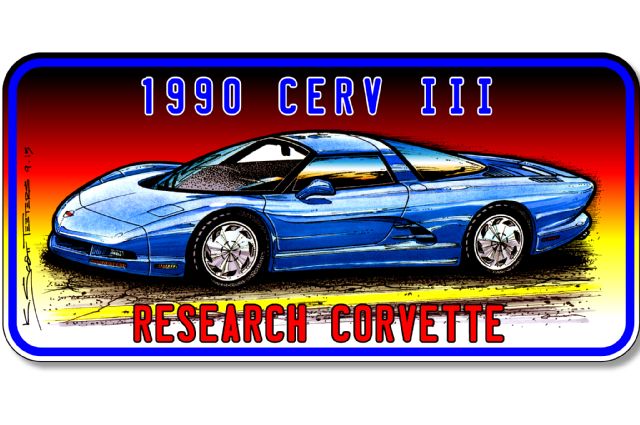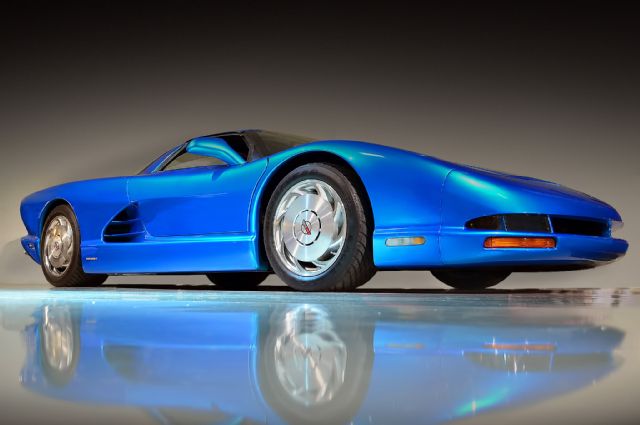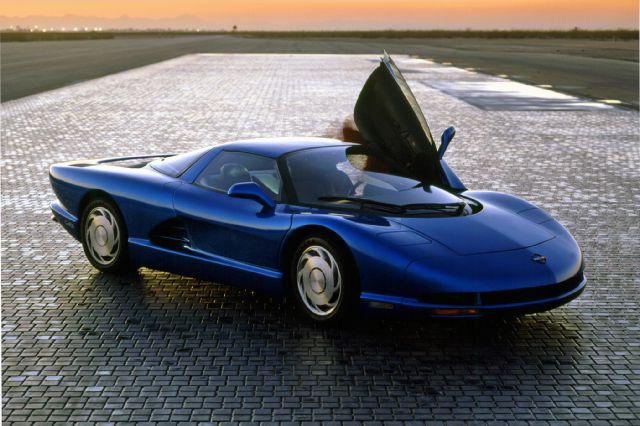
Words and Art by K. Scott Teeters as written for Vette Magazine and republished from SuperChevy.com
Read the other Experimental Vettes Stories HERE.
Trend Setting, Part 13: A look back at Chevrolet’s experimental, prototype, concept car, and show car Corvettes
The CERV III was a real-world version of the Corvette Indy show car. It was also the first functional, electronic high-tech Corvette concept car. There was a long, dry spell of Corvette concept cars after the mid-engine 4-Rotor/Aerovette. Not only did the Corvette go through a total redesign, but electronic computer-control systems enabled fuel-injection to come back and along with it, solid, ’60s-like performance with modern emissions ratings on unleaded gas. Computers were the best thing to happen to the Corvette since the big-block. Now it was time to see how far the envelope could be pushed.
The Corporate Engineering Research Vehicle III (CERV III) was more than pretty show car; it would be the most advanced Corvette study to date. Chief of Chevy III Studio Jerry Palmer handled the styling details, while Dick Balsey was the engineer on the project. The objective was to showcase the Chevrolet design team and Lotus’ advanced racing experience. This was no easy task, by any means. Fullsize clay models and even running prototypes were one thing, a real production car is another. Since this was to be an R&D, as well as a showcase car, only the most exotic materials of the day were used. That aside, everything else was built to be near-production line ready.

The nose of the Indy had to be shortened and raised to meet bumper standards and the side windows flattened out so that they could go down into the doors. The wheel openings had to be opened up to allow 3.5 inches of travel and the rocker panels reshaped to accommodate side-mounted fuel cells. Also, the overall height had to be increased a few inches.
Go up to 50k Miles Before Cleaning w/ K&N.
Since the car was completely built by race car builders Lotus in England, carbon fiber was used everywhere possible. The underbody was carbon fiber with a fiberglass-finish coating. Honeycomb aluminum was used extensively for reinforcement. The classic Lotus backbone chassis was made of carbon fiber and weighed only 38 pounds. The body was separate from the chassis and was attached by four hydraulic mounts. The complete body could be lifted off with the aid of quick-disconnect fittings for all of the electric and fuel lines. Power steering for the four-wheel-steering and the air-conditioning systems were mounted in the nose. The sides were filled with intercoolers, coolers for the active suspension and transmission, dry-sump oil system, and a fuel cell in each side for a combined 23.3-gallons.
Although the suspension looked normal, the springs and A-arms were made of titanium. Actuators were used in place of shock absorbers and were connected to a state-of-the-art computer-controlled active suspension system. ABS braking and traction control was also part of the package. The active suspension constantly measured pitch, yaw, and tire slippage on all four wheels – making adjustments as needed. The exotic suspension of the new C7 started here. The unique disc brakes used fixed calipers and dual rotors to double the braking surface that gripped from the inside of the rotors. The transverse-mounted engine used a six-speed automatic transmission that used two Turbo-Hydramatic 425 transmissions, modified with pieces from a 475 transmission. A transfer case drove front and rear posi differentials for all-wheel-drive and four-wheel steering system.
The CERV III’s engine was just as exciting as the body shape. The yet to be released LT5 engine that would eventually power the 1990-’95 ZR-1 was treated to two Garrett T3 turbochargers that bumped the horsepower up to 650 and the torque to 655 lb-ft. The 3,400-pound CERV III ran 0-to-60 in 3.9 seconds, had a “calculated” top speed of 225 mph, and had 1.1 g’s of lateral acceleration! This is C6 ZR1 territory in the late ’80s!
So what happened, why wasn’t the C5 based on the CERV III? Before the CERV III was shown at the 1990 Detroit Auto Show it was driven over 2,000 miles. That’s not a lot as an R&D car, but enough to prove the car’s roadworthiness, and a handful of guys had a great time, too. But Corvette sales were almost half that of 1985 figures, and Detroit was in another major slump. Besides, it was never Chevrolet’s intention to take the CERV III into production; this was a pure research vehicle – a testbed for advanced electro-mechanical designs, that’s why production specifications were put into the design. Designing cars in an electro-mechanical world is more than sculpting sexy-looking shapes.
Numbers were crunched on the CERV III as it was shown to the public. Customers would have been looking at a staggering $300,000 to $400,000 car – on par with the Ferrari F40 and the Porsche 959. CERV III was the last mid-engine Corvette prototype ever built, that is unless we ever see the C8 Zora.

